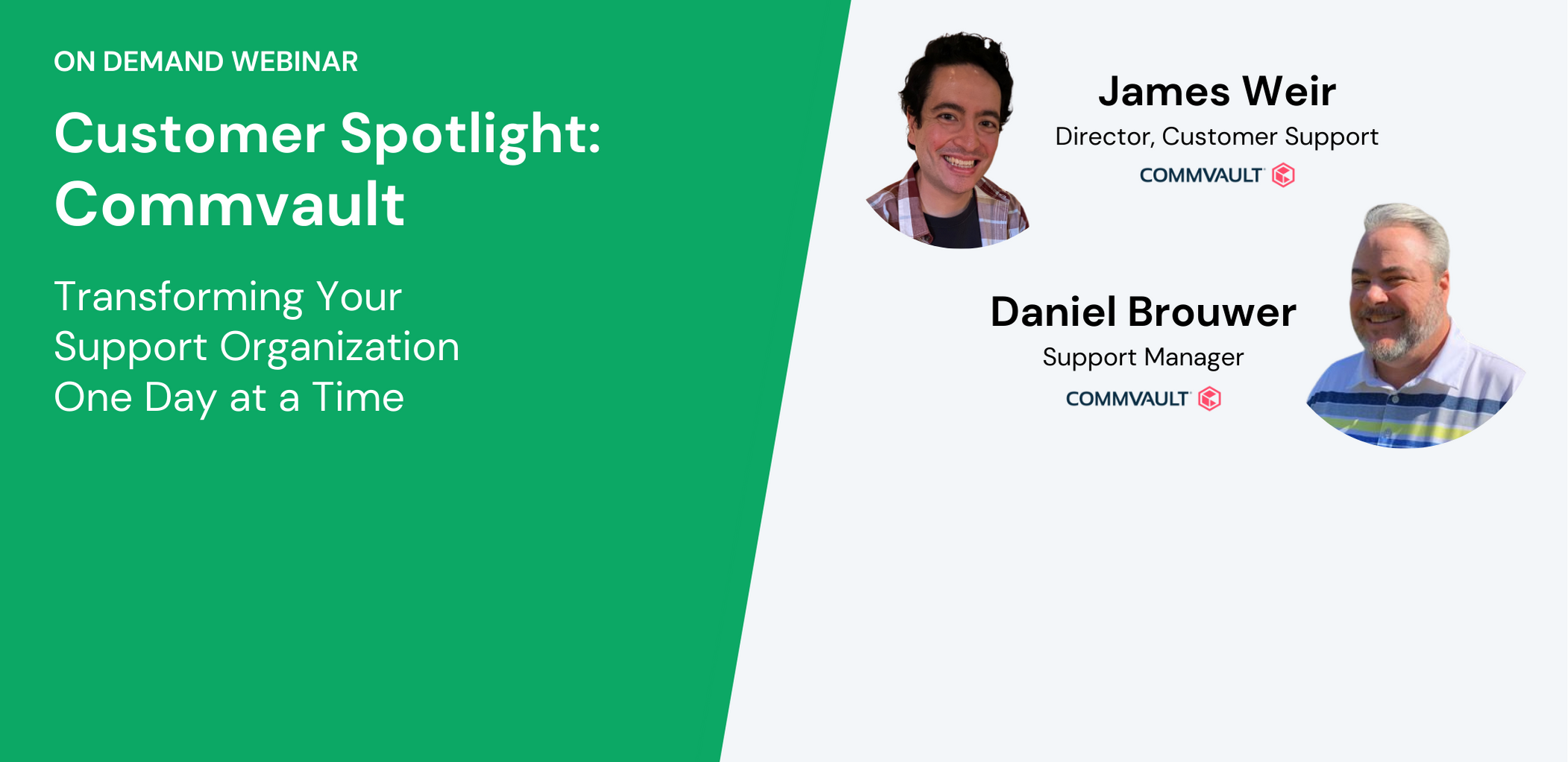
Jan 17, 2022
4 Takeaways from Commvault About Making Great Support Even Better
B2B supportcustomer escalationscustomer sentiment analysissupport operations
I sat down with Commvault’s Director of Customer Support James Weir and Support Manager Daniel Brouwer about how they use SupportLogic to reduce escalations and make an excellent CSAT even better.
The 45-minute discussion touched on reducing escalations, how sentiment labeling can help recognize and reward great performance by support team members, how Commvault got their team excited about adopting a new tool, and more. Here are the biggest lessons from the webinar.
Choose a purpose-built support experience solution
Commvault has a strong history of creating and customizing their own in-house tools to meet their needs. As Daniel said, “We’ve always been kind of a build-your-own shop… instead of trying to fit our business into this box, we try to find a tool that matches our box.” For example, they heavily customized Microsoft Dynamics to suit their CRM needs.
But when it came to a solution for reducing escalations, they decided building wasn’t the right move. Building or customizing in-house solutions can be time- and resource-intensive and requires continuous maintenance and updates. “There’s a lot of regression testing that we have to do, even to keep up with Microsoft’s update cycle… having another thing that we’d have to manage was a little daunting,” Daniel said.
The costs of building an in-house solution become even more apparent once you take scale into consideration. Commvault currently has 250+ support engineers and handles 40,000+ cases per year, and they expect to keep growing. At this size, it’s tough for them to justify building and maintaining an in-house tool. “As we grow, there’s more data, and getting through that data [to find potential escalations] is tough,” Daniel said.
By choosing SupportLogic, Commvault gets to focus on what they’re best at—keeping customers happy—while getting meaningful, usable case data from a trustworthy partner.
Get proactive to prevent escalations
To keep customers happy, Commvault doesn’t just promptly deal with escalations. They try to keep the escalations from happening in the first place.
Commvault uses SupportLogic’s sentiment labeling to find and address cases that may be trending toward escalation. They also train SupportLogic’s algorithm by relabeling false positives, making the tool better at identifying potential escalations:
“We had a customer that said, ‘I have to take my server down for maintenance,’ and it got flagged as negative sentiment. So for machine learning purposes, we edited the label on that negative sentiment—adjusted it to helpful or good information. And going forward that won’t be flagged the same way.” —James Weir, Commvault
The Commvault team also uses SupportLogic to identify high-touch support cases. These cases may not have been flagged as potential escalations yet, but they’ve generated a lot of messages between the support engineer and the customer—which may be frustrating for the customer.
“It’s not always necessarily a negative comment from a customer,” said James. “Sometimes it’s just a matter of, this has been going on through 100 back and forth messages. And you’re like, ‘This needs more attention. This is really not progressing the way it should have.’”
When escalations do occur, SupportLogic quickly brings cases to the support team’s attention by pushing an alert to Microsoft Teams. James said Commvault capitalizes on the timely alerts by reacting promptly to them: “We can immediately have a conversation through email or Teams and say, ‘Did you see that negative sentiment that just came in? What are we doing with that?’”
Seek out positive feedback to build morale and find advocates
When you’re trying to prevent cases from escalating, it’s easy to only focus on customer issues. But Commvault generates extra value from SupportLogic by using it to find and highlight positive customer experiences, too.
Commvault uses sentiment labeling to find thank-you messages and other positive customer comments. Daniel says they use those comments to recognize and reward support engineers: “We can call out the things that our engineers are doing well and say, ‘Hey, great job this morning.’” He even hands out “VIP chips” to team members who generate positive customer feedback. Team members can exchange VIP chips for various prizes.
Sentiment labeling also helps Commvault find potential fans and advocates among their customer base. “It’s about being able to look at customers and go, ‘Who are those customers that may not fill out a lot of surveys but are happy with Commvault?’” said Daniel. “We can start to identify and reach out to those customers,” who are potential sources of testimonials and case studies.
Empower your early adopters and evangelists
Commvault wanted to make sure that the support team embraced SupportLogic and got as much value as possible from it. They knew that support managers would be key to getting the rest of the team to buy into learning a new tool, so they prioritized turning these team leaders into fans and advocates of SupportLogic.
To help support managers learn and get excited about SupportLogic, Commvault’s support leadership team asked them to meet with SupportLogic’s team in daily 15-30 minute scrum meetings. In these sessions, the Commvault and SupportLogic teams discussed how Commvault was using the tool as well as any issues or feature requests that came up. These scrums were not top-down “here’s how to use the tool” teaching sessions from SupportLogic but rather conversational “How are you using it?” discussions that put Commvault’s support managers in the driver’s seat.
A daily meeting with a vendor might seem like just one more obligation for managers to absorb, but for Commvault, the value was obvious. “It’s all about the customer experience and making sure the customers are happy,” said James. “To invest 15-30 minutes, I don’t think that’s a lot of time.”
As Commvault’s lead managers got comfortable with SupportLogic, they began to introduce the tool to associate support managers and then support engineers. This phased approach made it easier for support managers to become advocates for the tool and also created curiosity among the support team around SupportLogic.
“When you’re going to roll out any application, you have to find those champions, those people that are early adopters,” said Dan. “If you have an early adopter, they’re gonna evangelize it. And then what happens is other people will hear about it and they’re like, ‘Well, why does Dan get this great tool? I want to get involved.’”
How to learn more
Get started with a Test Drive today.If you missed the live webinar, you can watch it on-demand here. We’d love to hear what you think!
Don’t miss out
Want the latest B2B Support, AI and ML blogs delivered straight to your inbox?





